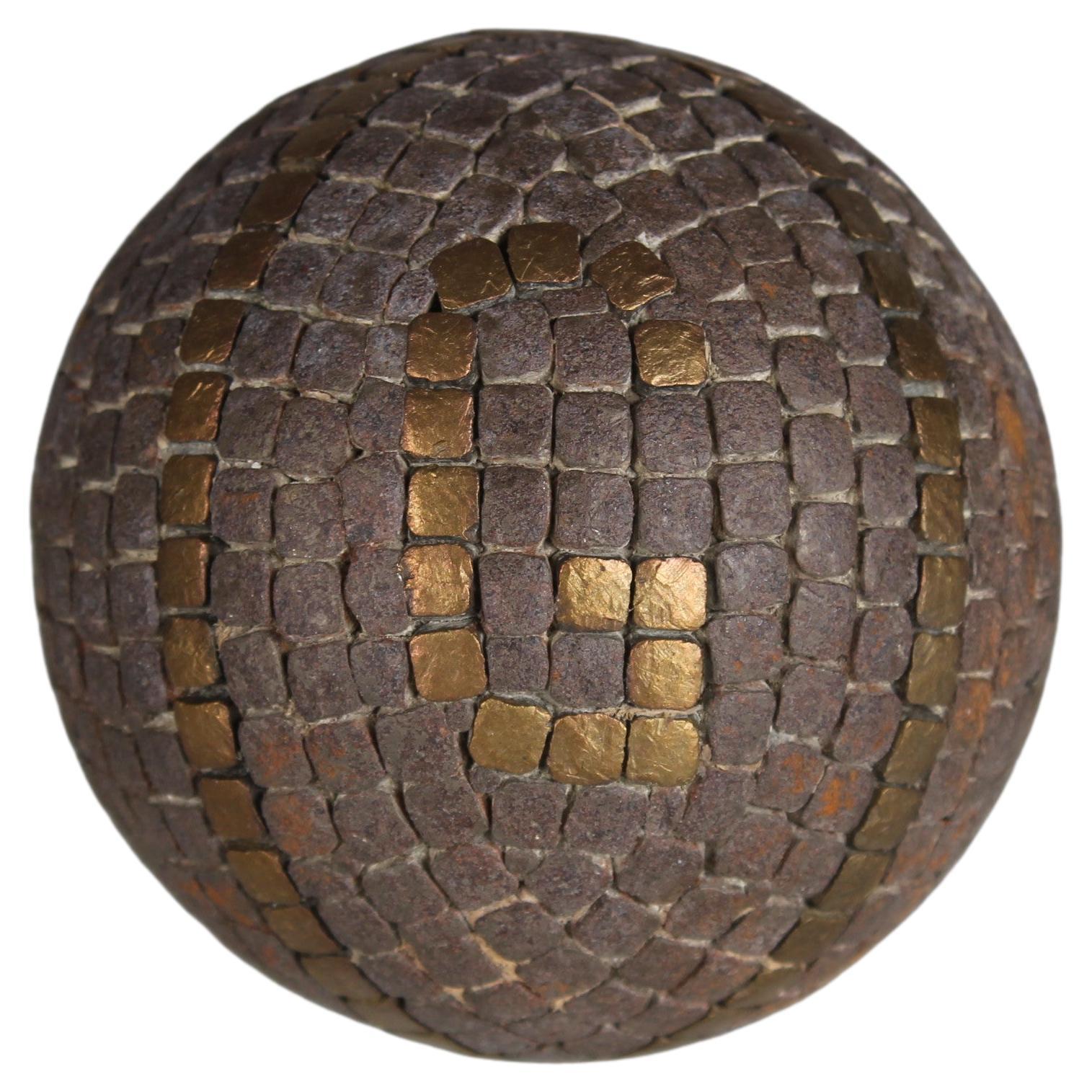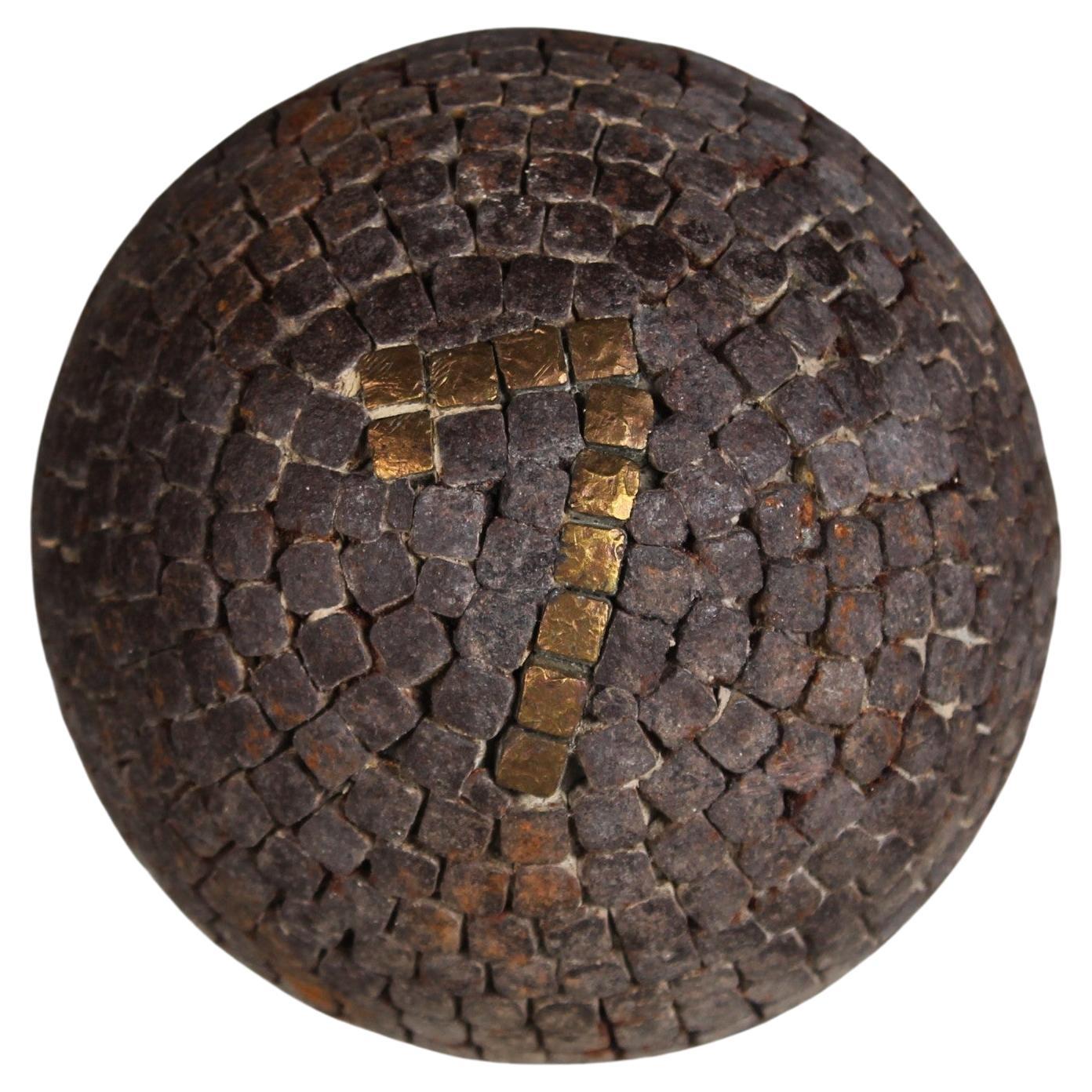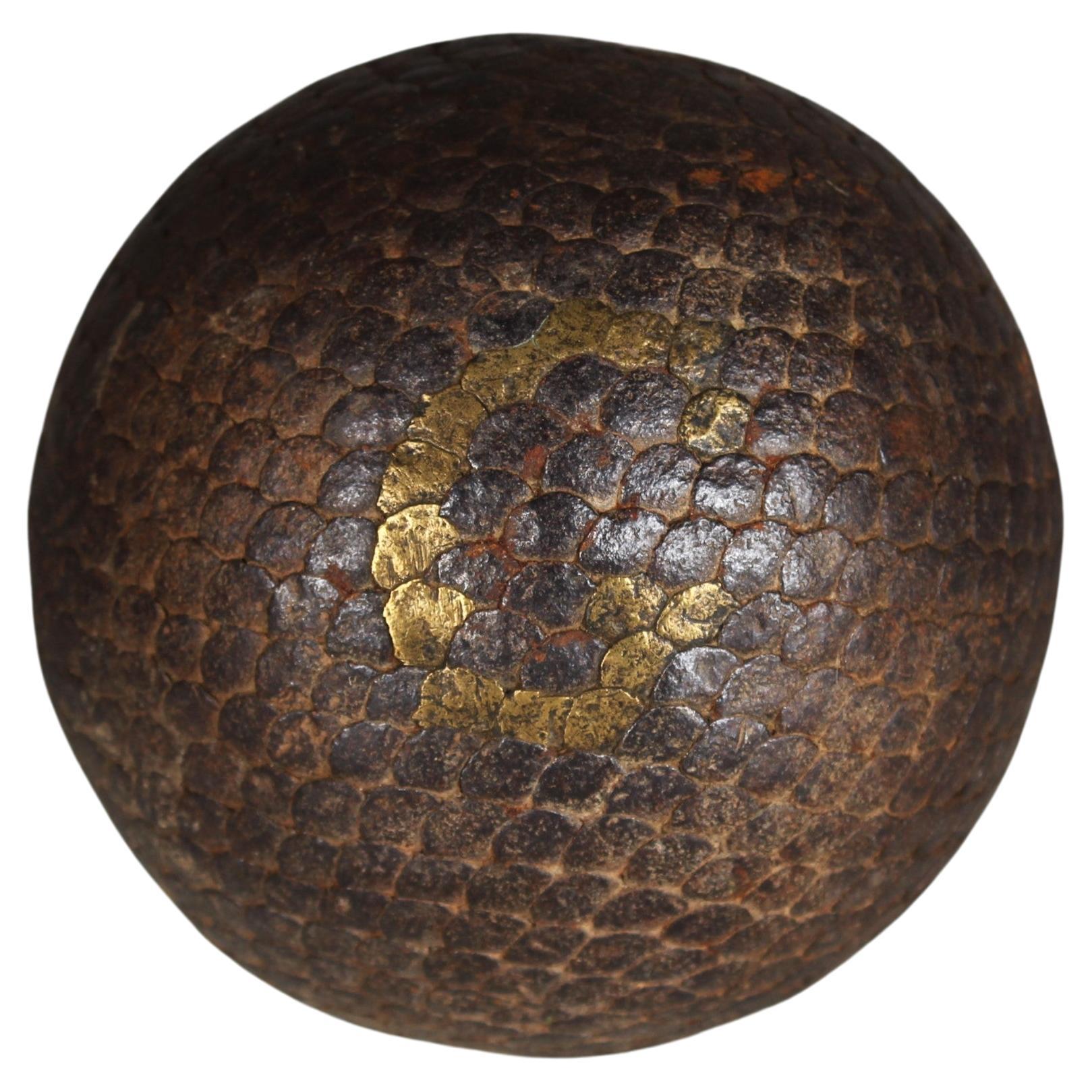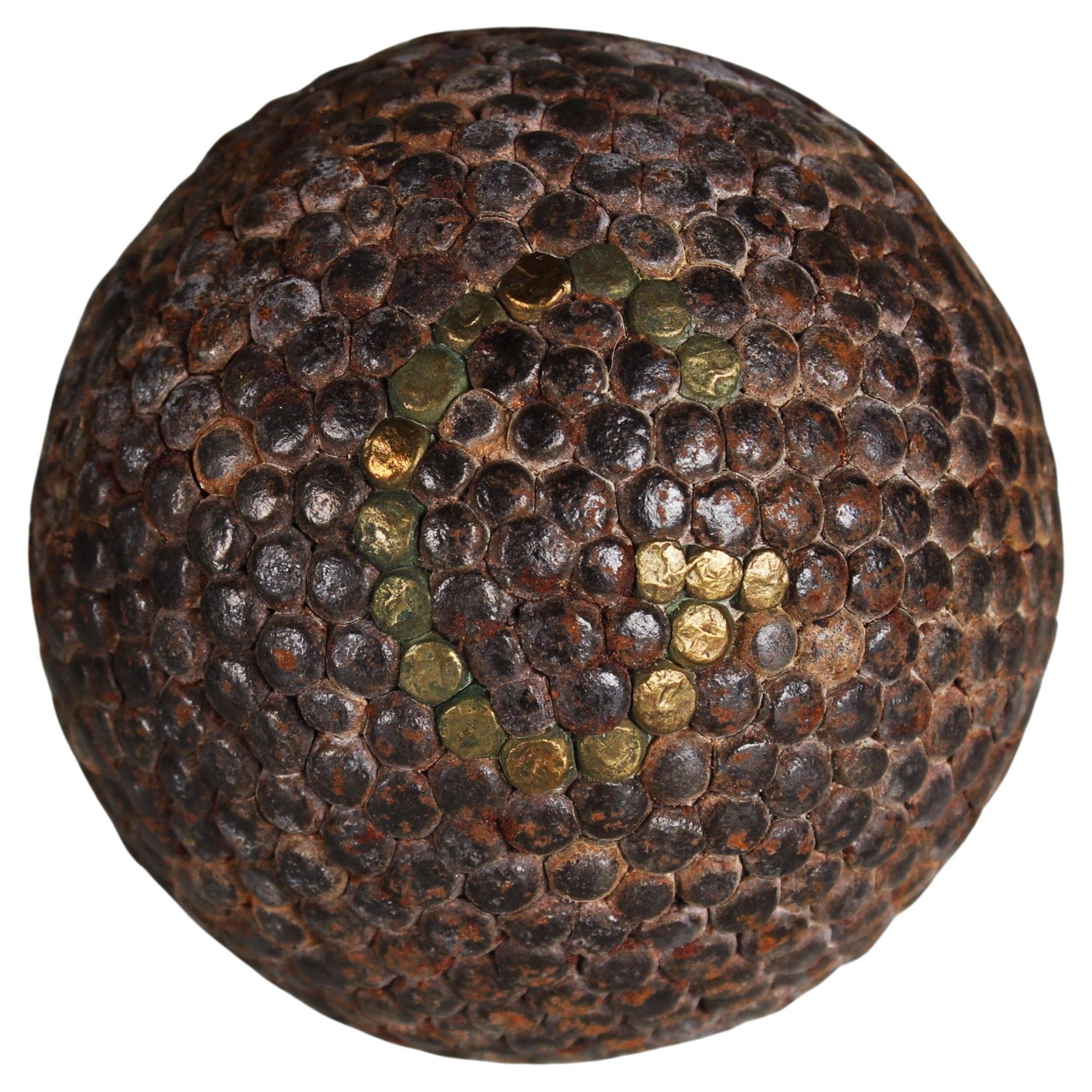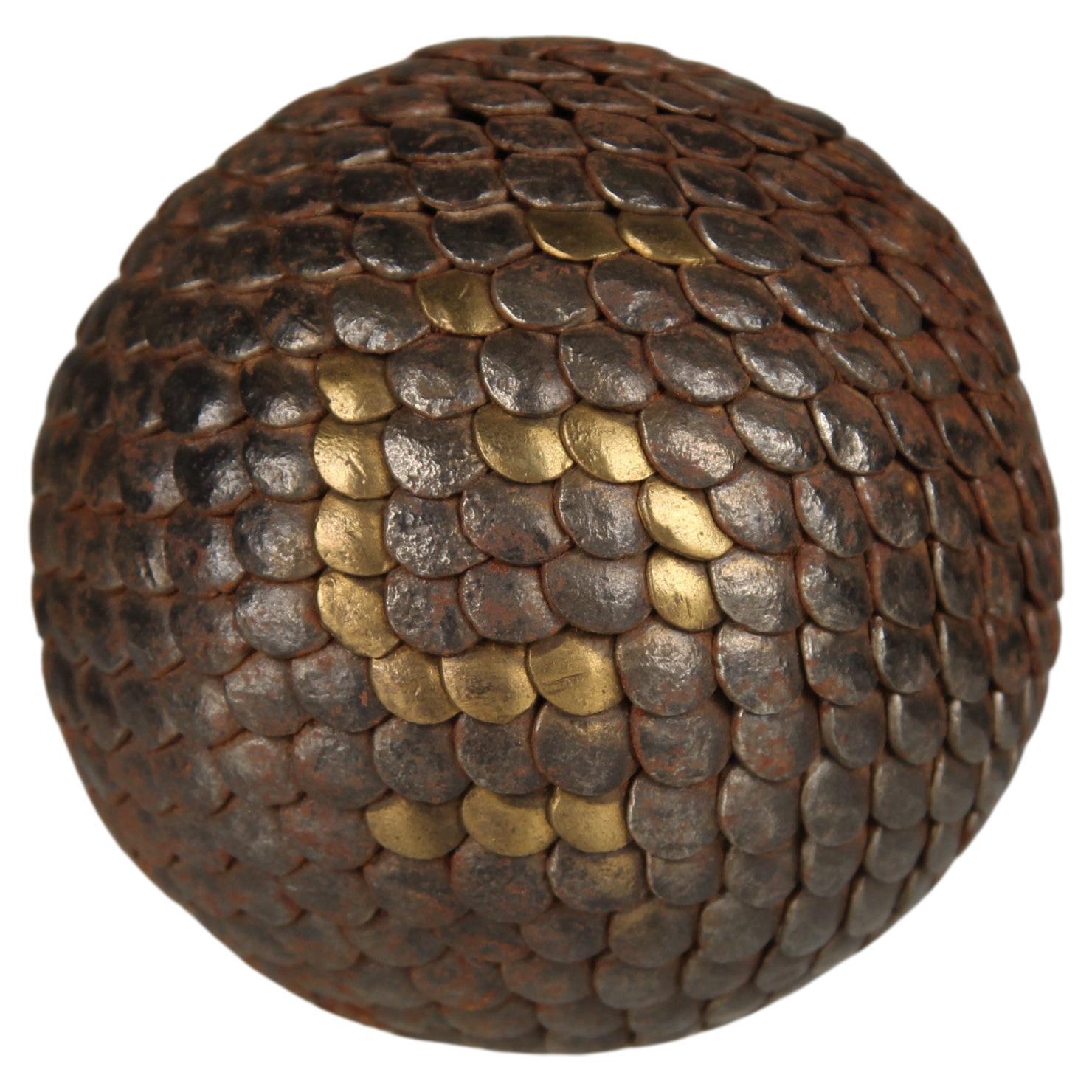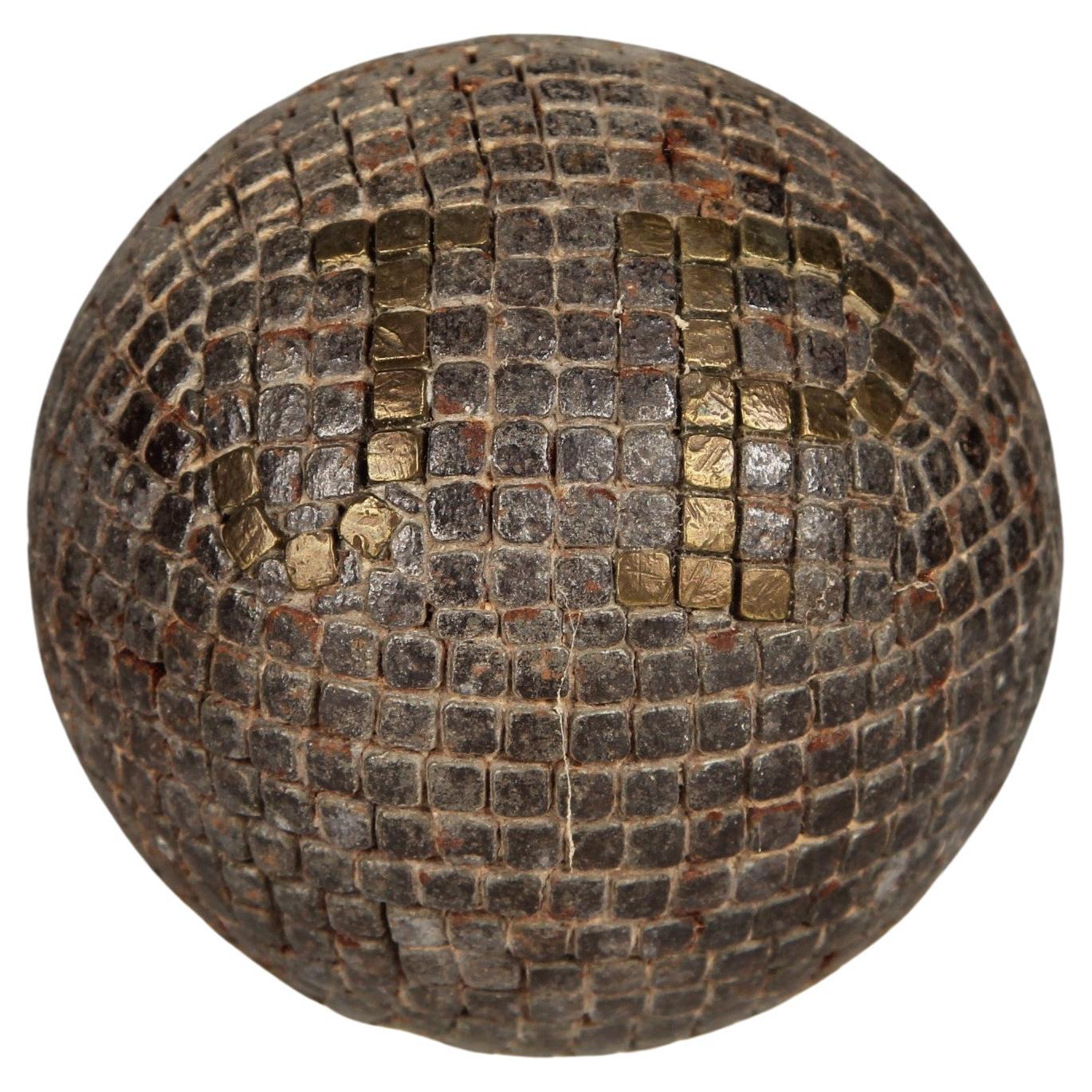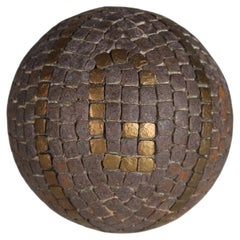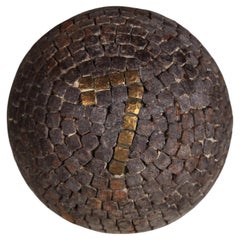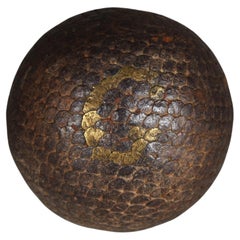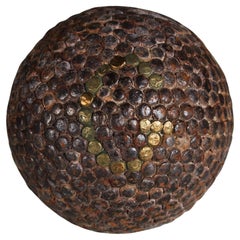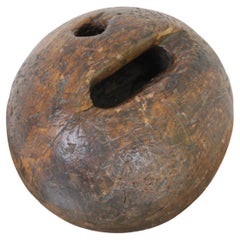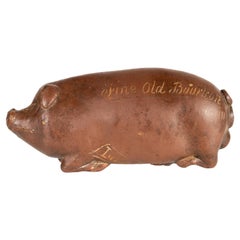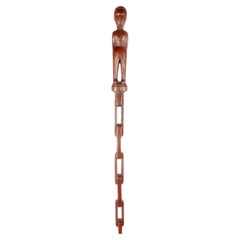Items Similar to Antique Boule Ball "D F", Pétanque, 1880s, France, Craftsmanship
Want more images or videos?
Request additional images or videos from the seller
1 of 8
Antique Boule Ball "D F", Pétanque, 1880s, France, Craftsmanship
About the Item
Beautiful, unique Boule ball, France, late 19th Century.
In the 19th century, the manufacture of boules balls underwent significant development in France as the game of boules, particularly the pétanque variant, gained in popularity. The manufacture of boules balls during this period was a manual process that required expertise, precision and love to detail.
In the late 19th and early 20th centuries, particularly in rural areas of France and other Mediterranean regions, olive wood was a commonly used source of material for making boules balls. This was not only due to the availability of the material, but also to the outstanding properties of olive wood, which was characterized by hardness, strength and a rich grain.
First, the olive wood was carefully selected and shaped into raw balls, which were then sanded to the desired size and shape. The nails were then hammered into the balls one by one, making sure that they were evenly distributed and firmly anchored. Finally, the spheres were polished and coated with a protective varnish to enhance their natural beauty and protect them from the elements.
The use of nails to decorate and reinforce olive wood boules was a traditional practice that not only gave the ball a rustic aesthetic, but also improved its durability and contributed to customization. Many balls were made according to the specific requirements and preferences of the players. Nails were driven at regular intervals around the ball, with each nail hole precisely placed so as not to affect the balance and weight distribution of the ball. These nails not only served as a decorative element, but also helped to strengthen the structure of the ball and make it more resistant to the hard knocks and wear and tear during play. Individual engravings or decorations were often applied to the balls to make them unique and identify the player.
Antique boules are now sought-after collector's items, representing not only the history and tradition of the game of boules, but also the craftsmanship and cultural heritage of the regions in which they were made.
Each ball tells a story of craftsmanship and local artisanship that continues to be admired over time.
- Dimensions:Height: 3.55 in (9 cm)Diameter: 3.55 in (9 cm)
- Style:Late Victorian (Of the Period)
- Materials and Techniques:
- Place of Origin:
- Period:
- Date of Manufacture:Circa 1880
- Condition:Wear consistent with age and use. Very nice, age-related and cleaned condition.
- Seller Location:Greven, DE
- Reference Number:1stDibs: LU5419240455272
About the Seller
4.9
Platinum Seller
Premium sellers with a 4.7+ rating and 24-hour response times
Established in 2014
1stDibs seller since 2020
177 sales on 1stDibs
Typical response time: <1 hour
- ShippingRetrieving quote...Shipping from: Münster, Germany
- Return Policy
Authenticity Guarantee
In the unlikely event there’s an issue with an item’s authenticity, contact us within 1 year for a full refund. DetailsMoney-Back Guarantee
If your item is not as described, is damaged in transit, or does not arrive, contact us within 7 days for a full refund. Details24-Hour Cancellation
You have a 24-hour grace period in which to reconsider your purchase, with no questions asked.Vetted Professional Sellers
Our world-class sellers must adhere to strict standards for service and quality, maintaining the integrity of our listings.Price-Match Guarantee
If you find that a seller listed the same item for a lower price elsewhere, we’ll match it.Trusted Global Delivery
Our best-in-class carrier network provides specialized shipping options worldwide, including custom delivery.More From This Seller
View AllAntique Boule Ball "G", "J", Pétanque, 1880s, France, Craftsmanship
Located in Greven, DE
Beautiful, unique Boule ball, France, late 19th Century.
Decorated with the initials "G" and "J".
In the 19th century, the manufacture of boules balls underwent significant developm...
Category
Antique Late 19th Century French Late Victorian Antiquities
Materials
Olive
Antique Boule Ball "7", Pétanque, 1880s, France, Craftsmanship
Located in Greven, DE
Beautiful, unique Boule ball, France, late 19th Century.
In the 19th century, the manufacture of boules balls underwent significant development in France as the game of boules, particularly the pétanque variant, gained in popularity. The manufacture of boules balls during this period was a manual process that required expertise, precision and love to detail.
In the late 19th and early 20th centuries, particularly in rural areas of France and other Mediterranean regions, olive wood was a commonly used source of material for making boules balls. This was not only due to the availability of the material, but also to the outstanding properties of olive wood, which was characterized by hardness, strength and a rich grain.
First, the olive wood was carefully selected and shaped into raw balls, which were then sanded to the desired size and shape. The nails were then hammered into the balls one by one, making sure that they were evenly distributed and firmly anchored. Finally, the spheres were polished and coated with a protective varnish to enhance their natural beauty and protect them from the elements.
The use of nails to decorate and reinforce olive wood boules was a traditional practice that not only gave the ball a rustic aesthetic, but also improved its durability and contributed to customization. Many balls were made according to the specific requirements and preferences of the players. Nails were driven at regular intervals around the ball, with each nail hole precisely placed so as not to affect the balance and weight distribution of the ball. These nails not only served as a decorative element, but also helped to strengthen the structure of the ball and make it more resistant to the hard knocks and wear and tear during play. Individual engravings or decorations were often applied to the balls to make them unique and identify the player.
Antique boules...
Category
Antique Late 19th Century French Late Victorian Antiquities
Materials
Metal
Antique Boule Ball "G", Pétanque, 1880s, France, Craftsmanship
Located in Greven, DE
Beautiful, unique Boule ball, France, late 19th Century.
In the 19th century, the manufacture of boules balls underwent significant development in France as the game of boules, particularly the pétanque variant, gained in popularity. The manufacture of boules balls during this period was a manual process that required expertise, precision and love to detail.
In the late 19th and early 20th centuries, particularly in rural areas of France and other Mediterranean regions, olive wood was a commonly used source of material for making boules balls. This was not only due to the availability of the material, but also to the outstanding properties of olive wood, which was characterized by hardness, strength and a rich grain.
First, the olive wood was carefully selected and shaped into raw balls, which were then sanded to the desired size and shape. The nails were then hammered into the balls one by one, making sure that they were evenly distributed and firmly anchored. Finally, the spheres were polished and coated with a protective varnish to enhance their natural beauty and protect them from the elements.
The use of nails to decorate and reinforce olive wood boules was a traditional practice that not only gave the ball a rustic aesthetic, but also improved its durability and contributed to customization. Many balls were made according to the specific requirements and preferences of the players. Nails were driven at regular intervals around the ball, with each nail hole precisely placed so as not to affect the balance and weight distribution of the ball. These nails not only served as a decorative element, but also helped to strengthen the structure of the ball and make it more resistant to the hard knocks and wear and tear during play. Individual engravings or decorations were often applied to the balls to make them unique and identify the player.
Antique boules...
Category
Antique Late 19th Century French Late Victorian Antiquities
Materials
Metal
Antique Boule Ball "G", Pétanque, 1880s, France, Craftsmanship
Located in Greven, DE
Beautiful, unique Boule ball, France, late 19th Century.
In the 19th century, the manufacture of boules balls underwent significant development in France as the game of boules, particularly the pétanque variant, gained in popularity. The manufacture of boules balls during this period was a manual process that required expertise, precision and love to detail.
In the late 19th and early 20th centuries, particularly in rural areas of France and other Mediterranean regions, olive wood was a commonly used source of material for making boules balls. This was not only due to the availability of the material, but also to the outstanding properties of olive wood, which was characterized by hardness, strength and a rich grain.
First, the olive wood was carefully selected and shaped into raw balls, which were then sanded to the desired size and shape. The nails were then hammered into the balls one by one, making sure that they were evenly distributed and firmly anchored. Finally, the spheres were polished and coated with a protective varnish to enhance their natural beauty and protect them from the elements.
The use of nails to decorate and reinforce olive wood boules was a traditional practice that not only gave the ball a rustic aesthetic, but also improved its durability and contributed to customization. Many balls were made according to the specific requirements and preferences of the players. Nails were driven at regular intervals around the ball, with each nail hole precisely placed so as not to affect the balance and weight distribution of the ball. These nails not only served as a decorative element, but also helped to strengthen the structure of the ball and make it more resistant to the hard knocks and wear and tear during play. Individual engravings or decorations were often applied to the balls to make them unique and identify the player.
Antique boules...
Category
Antique Late 19th Century French Late Victorian Antiquities
Materials
Metal
Antique Boule Ball "J P", Pétanque, 1880s, France, Craftsmanship
Located in Greven, DE
Beautiful, unique Boule ball, France, late 19th Century.
In the 19th century, the manufacture of boules balls underwent significant development in France as the game of boules, part...
Category
Antique Late 19th Century French Late Victorian Antiquities
Materials
Metal, Brass
Antique Boule Ball "6", Pétanque, 1880s, France, Craftsmanship
Located in Greven, DE
Beautiful, unique Boule ball, France, late 19th Century.
In the 19th century, the manufacture of boules balls underwent significant development in France as the game of boules, part...
Category
Antique Late 19th Century French Late Victorian Antiquities
Materials
Metal, Brass
You May Also Like
Boule ball hard wood
Located in Diest, BE
French ball from a folk art game. Great patina and form.
Normandy, France ca. 1860
Category
Antique 1860s French French Provincial Antiquities
Materials
Wood
Genuine 1880s Albany Slip Glazed Anna Pottery Stoneware Pig Flask
Located in Coeur d'Alene, ID
Albany slip glazed Anna pottery stoneware pig flask by Wallace and Cornwall Kirkpatrick, Anna. Anatomically correct prone pig. In sized inscriptions "Fine Old Burmann Inn" and alongside "Lard Oil Drill". Underside flask opening under tail. Anna Pottery was s operative by the Kirkpatrick brothers between 1859 and 1896. They took part in art exhibitions such as Philadelphia Centennial in 1876 and the World's Columbian Exposition in Chicago 1893. In 1938 the first inscription of Anna pottery was published in the New York Historical Society. Pieces of Anna pottery pigs...
Category
Antique 1880s American Pottery
Materials
Pottery
$6,000 Sale Price
40% Off
Folk art walking stick depicting a man on a chain-shaped shaft, USA 1880s.
Located in Milan, IT
Folk art walking stick of American folk art.
The stick is made entirely from a single branch of fruit wood, carved and ingraved. The tip is made of copper, smooth with decorative lin...
Category
Antique 1880s American Antiquities
Materials
Copper
Vintage 20th-Century Floral Ceramic Wall Fountain - French Craftsmanship - 2Y551
Located in Bordeaux, FR
Enhance your decor with this beautiful vintage ceramic wall fountain from the 20th century, featuring an elegant floral design. Measuring 68.5 cm in height, 33.5 cm in length, and 17...
Category
20th Century Antiquities
Materials
Ceramic
Antique Carved Wooden Wall Console with Angel. 1850 - 1880
Located in CADALSO, ES
Great condition
Category
Antique 1850s German Victorian Antiquities
Materials
Wood
Large Antique Steer Weathervane c. 1880
Located in Lancaster, PA
Beautiful antique weathervane most likely by Cushing and White. Origin is New England c. 1880. This weathervane was purchased from Allan Katz Amer...
Category
Antique Late 19th Century American Folk Art Antiquities
Materials
Copper
Recently Viewed
View AllMore Ways To Browse
Folk Art Wood Carved French
Antique Boule
Glass Trolleys
Italian Regency Table
Murano Glass Table Lamp Base
Chairs With Cabriole Leg
Custom Made Sofa
Distressed Persian Rug
European Black Lacquer Furniture
French White Chair
Frieze Drawer
High Society Poster
Hungarian Art Nouveau Chair
Large Wood Work Table
2 Lounge Chairs
Art Deco Rug Mid Century
French Art Deco Glass Lamps
Glass Pendant Light Art Deco
